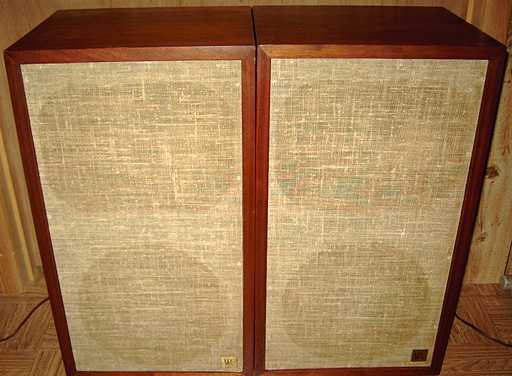
I have always been curious about the sound quality of AR speakers from the late 1960's - early 70's. Acoustic Research AR-2ax speakers cost $128 each in 1971. When a pair of these showed up at the local resale emporium, my curiosity was piqued. Connecting a sound source, I knew immediately why they had ended up at the resale shop. Only the bass drivers were working. Nothing came out of the mid-range and tweeters except a bit of distorted noise.

AR speakers are "acoustic suspension" systems for which Acoustic Research held a patent. The speaker cabinets are sealed air tight. The AR speakers are designed to remain sealed and not to be opened by the user.
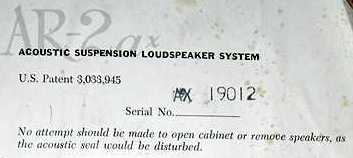
Opening sealed AR speakers
AR made sure that opening the cabinets was difficult at best by stapling the grille cloth board to the cabinet. Their 5 year warranty card, attached with the same staples on the back of the speaker, also stated not to open the cabinets.
I gently pulled all 20 staples from each speaker grille using a thin blade screwdriver to gently get under the staples and rocking the screwdriver side to side to force the staples up. There were 4 staples on each edge and four in the center area. The staples are in line with the grille cloth weave so as to hide their presence.
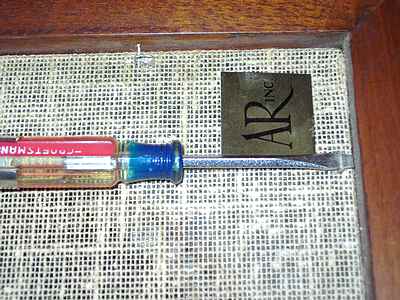
After the staples were removed, the grille board has to be lifted gently from the cabinet. It is glued in the center and at the edges. I used a flat piece of metal bent with a 90 degree lip as a tool to get under the edge of the grille board to lift a corner. The AR emblem can also be pulled up a bit to lift one corner.
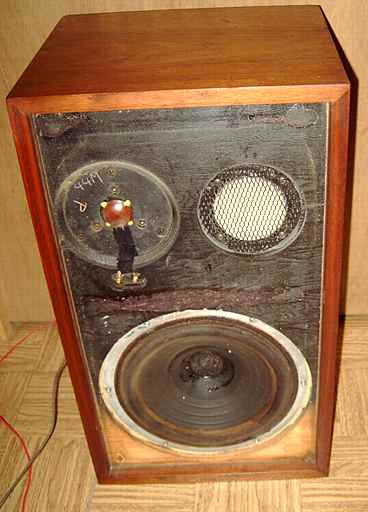
Thankfully, this series of AR speakers did not use foam for the speaker cone surrounds. The woofer has what appears to be an impregnated cloth material for the cone surround. I tested the woofers for integrity and compliance and found them to be in excellent condition. The tweeters and mid-range speakers were also in fine condition.
The woofer has to be pulled to gain access to the inside crossover and controls. The woofer basket is very well constructed of cast aluminum with an embossed AR logo. It is held by six Philips screws. After removing the screws, the woofer will still be held down by the air-tight putty seal. I used the bent metal tool to get under the edge of the metal basket and rocked the tool to loosen and lift the basket from the seal. After removing the woofer, I removed and set aside a thin cloth-like shroud material placed under the woofer to keep the fiberglass batts from touching the speaker. Using protective gloves, I removed the fiberglass batts and set them aside. The crossover and the level controls for the mid range and tweeter were accessible after removal of the fiberglass below the woofer.
Troubleshooting
A continuity check with an ohmmeter quickly confirmed my suspicions. The potentiometer level controls for the mid range and tweeter were nearly open circuits. I removed the pots and opened them. They were corroded inside with a blue-green color. I assume that the dissimilar metal of the resistance wire and the moving contact had set up a galvanic reaction.
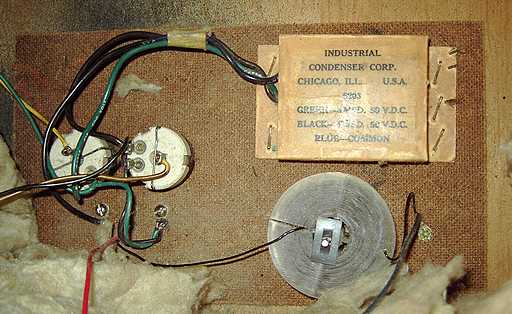
I cleaned one of the pots but the corrosion had eaten parts of the moving contact. All four controls from the two speakers had similar problems.
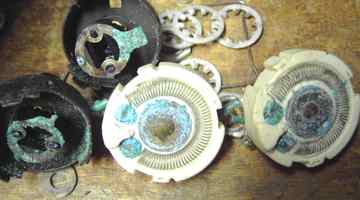
I decided not to replace the controls inside the cabinet but to feed the control wires through the respective shaft holes left after removing the pots. I used wire nuts to connect the wires externally to the max level setting for the tweeter and the mid-range pots. Replacement control pots such as L-pads can easily be mounted external to the speaker cabinets thus avoiding any repeat of a problem inside the cabinets.
After verifying that the crossover components were in good order using a Sencore Z-meter, I replaced the fiberglass bats, the shroud, and the woofer. I used new plumber's putty in place of the old dried-out putty to provide the air tight seal between the woofer basket and the cabinet. I also used a bit of the putty to seal the control shaft holes now being used for wires to the exterior.
Measurement of the pots
The control level pots were each found to measure 14 ohms end to end. The recommended initial settings corresponding to the arrows on the back of the speakers are 2 ohms from the max setting for the tweeter, and the middle of the pot for the mid-range speaker. Since the pots are a source of problems, I have not yet decided whether to replace them permanently with external units or simply opt to use a few external power resistors for equivalent settings after determining the proper levels.
Problems with the level pots
The corrosion problems for the pots inside these AR-2ax speakers are not unique. Other have had similar experiences. If the original pots are still in your AR-2ax, then the sound quality has likely deteriorated.
The sound of quality
After repairs, I was not disappointed by the sound quality of the AR-2ax speakers. There is much subjectivity in describing the audio quality of speakers and other vintage audio components. However, I can say that the clarity and transparency that the AR engineers strived for is very much in evidence. Very few modern speakers sound so clean when driven by audio with tone controls or equalizer remaining flat. I very much enjoy listening to music with these speakers.
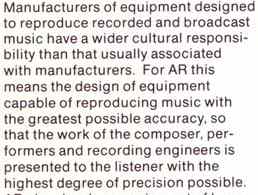
Reviews quoted by AR
Here are two review clips quoted by AR in their 1971 brochure.
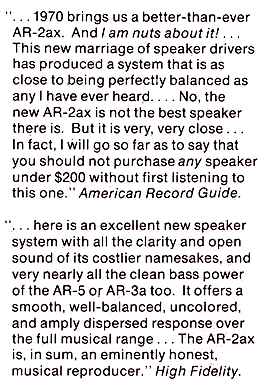
More info on AR speakers
The AR-2ax was reviewed in the September 1970 issue of High Fidelity magazine.
Classic speakers has an excellent set of references on AR and other speaker manufacturers.
A Dukane 1A475B "High Power" Audio Amp was the previous item on the bench.